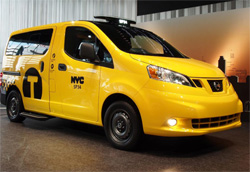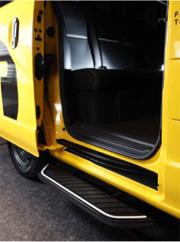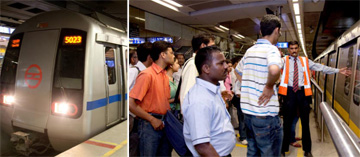Home > Highlighting JAPAN > Highlighting Japan AUGUST 2012 > International Departures
Highlighting JAPAN
COVER STORY: FUTURE TRANSPORT—Greener Ways to Get Around
International Departures
Environment-friendly transportation technologies developed in Japan are being applied in numerous cities overseas, improving traffic conditions and revitalizing urban environments. Masaki Yamada reports.

The Nissan NV200 was selected as New York City's official taxicab. Although compact in body size, it comes with ample legroom and a panoramic roof (with shades) to provide a good view of the city. It also satisfies all the requirements laid out for New York City taxis; in terms of factors such as safety, reducing environmental burden, and universal design.
Credit: TADASHI AIZAWA
Beginning in October 2013, the sixteen models currently used for taxis operating in New York City (the famous yellow cabs) will be gradually reduced to a single model, based on the NV200 compact van by Nissan Motor Co.
In renewing and unifying the taxi fleet, the city listed five must-have requirements of the vehicles: (1) realize levels of innovation and comfort previously unseen, (2) ensure the most up-to-date safety performance, (3) reduce impact on the environment, (4) minimize footprint on the road, and (5) pursue universal design for easy use by everyone. The NV200 satisfied all these requirements.

The sliding doors of the new cab offer easy access for passengers and are less of a roadside hazard than conventional car doors.
Credit: TADASHI AIZAWA
The car is equipped with a supplemental restraint system (SRS) curtain airbag system for both the front and rear seats, while using sliding doors reduces the risk of doors inadvertently opening in the way of pedestrians, cyclists or automobiles, and allows passengers to smoothly enter and exit. The vehicle's compact body reduces its footprint on the road, and fuel consumption has been improved by approximately 30% compared to the conventional taxi models and will significantly reduce carbon dioxide emissions.
New York City plans to replace all taxis operating inside the city, approximately 13,000 vehicles, with the NV200 within a five-year period. In addition, in consideration of future use of electric vehicles (EVs) as taxis, trial service of six Nissan Leaf EVs has been implemented in 2012.
By 2050, 70% of the global population is expected to be concentrated in urban areas. As this sort of extreme urbanization progresses, establishing a zero-emission society will become an even more essential theme than it is at present. Nissan intends to continue to focus attention on helping to realize a sustainable society with mobility by developing and popularizing automobiles that utilize their newest zero-emission technologies.

A Delhi Metro station, crowded with passengers. To help maintain order, the Japanese system of lines drawn on platforms with guards in attendance has been introduced. With its punctual operation and low impact on the environment, the Delhi Metro is extremely popular with the city's residents.
Credit: COURTESY OF SHINICHI KUNO/JICA
In India, where rapid economic growth is recently taking hold, urbanization is quickly progressing. In the capital territory of Delhi in particular, the population has grown to nearly 17 million, and continues to rise. Yet urban transport systems that support its citizens' movement had been left behind undeveloped while private car ownership grew in line with economic growth, resulting in chronic traffic congestion and serious atmospheric pollution caused by automobile exhaust. The Government of India, confronted by this pressing situation, formulated the Delhi Metro Project. At the Government of India's request, the Government of Japan decided to provide a soft loan together with technical support through the Japan International Cooperation Agency (JICA). JICA provided support for construction of the Delhi Metro for sixteen years from its planning stages. Following the completion of Phase I in November 2006 that covered the central part of the city, the addition of Phase II, spreading out to the perimeter areas, was fully completed in August 2011. Shohei Hayashi of the JICA South Asia Department comments:
"With the full completion of Phase II the total extension of the Delhi Metro has now reached 190 km; a network nearing the magnitude of the Tokyo Metro. The daily number of passengers has reached approximately 1.8 million and the Delhi Metro has firmly established itself as the legs of the people. It has gained a good reputation among its users too. By boarding a train at a fixed time, they will arrive at their school or office at a fixed time. We often hear people say that is has become much more convenient than the days of using buses gridlocked in traffic."
JICA has been supporting the construction of subways in Chennai, Bangalore, Kolkata, and other cities in India. The Delhi Metro was the first railway business in the world to be registered by the United Nations CDM Executive Board (CDM EB) as a Clean Development Mechanism (CDM). What drew the board's attention was the introduction of regenerative brakes, an energy-saving technology used in subway cars in Japan that converts the kinetic energy of a braking train into power. Use of this system yields a power savings of up to 33% compared to typical train carriages, enabling a yearly reduction of approximately 40,000 tons of carbon dioxide.
With the completion of the Delhi Metro, chronic traffic congestion has been reduced and the city now looks quite different. As the next step, JICA is now considering a subway construction project for Mumbai, one of India's largest cities. Similar projects are also proceeding in the Indonesian capital of Jakarta and in Ho Chi Minh City, Vietnam.

China's first monorail runs through Chongqing.
Credit: COURTESY OF HITACHI, LTD.
Japanese railway technology has also been employed in the construction of China's first monorail project, in Chongqing.
Chongqing is the largest industrial city in southwestern China and, like Delhi, it was faced with serious problems in traffic congestion in urban areas and a living environment compromised by factors such as air pollution. The city first planned for a conventional subway (Line 1) to resolve the issue, but around that time the sight of monorails running in urban areas in Japan suggested possibilities and the decision was made to introduce a monorail system as well. The monorail would not only function as the backbone traffic system in urban areas but also as a tourism resource in that it provides a sight unique for Chongqing.

Tourists enjoy viewing the trains from sightseeing boats on the river.
Credit: COURTESY OF HITACHI, LTD.
"The monorail is characterized by its safe and comfortable ride, and its potential to offer a wide variation of routing selections depending on the form of the city and the demand. It contributes to improving the scenic beauty of cities. Another big advantage is its short construction period and low construction cost compared to a conventional subway. In terms of environmental performance, the report on a preliminary survey estimated that while the total amount of carbon dioxide emissions from Chongqing buses was 15,926 tons, the monorail was approximately one-fifth of that, at 3,074 tons [estimated figures for 2010]."
The City of Chongqing is currently extending its monorail lines and by 2014 the total length is expected to reach approximately 90 km, a monorail network unmatched globally. Using the success in Chongqing as a foothold, Hitachi has supplied monorail systems to Singapore and to Dubai in the United Arab Emirates.
© 2009 Cabinet Office, Government of Japan






